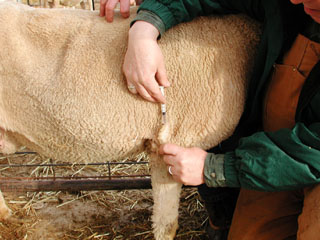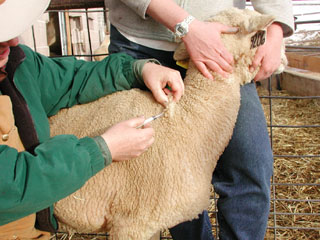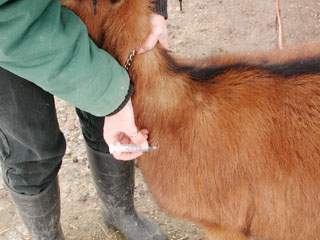
| This picture shows one location for a SQ injection. It is being administered behind the elbow. |
More Goat info, More Sheep info
BUY THIS MANUAL NOW and have access to this article and 100's of others just like it!
View some of the 10+ Video clips found in the Small Ruminant Manual
Introduction:
The two most common routes to administer injections are intramuscularly (IM) and subcutaneously (SQ or SC). A few products are given orally (per os - PO), intravenously (IV), or intranasally (IN). Giving vaccines or injections by the improper route can result in failure of the product and may result in local reactions.Subcutaneous (SQ or SC): A 1-inch needle of 18-20 gauge diameter should be used. The loose skin on the side of the neck or behind the elbow is a good location for SQ injections. These injections are given just below the skin, but not into the muscle. Substances injected SQ are not picked up by the blood supply as quickly as with IM injections, but greatly reduce carcass blemishes. To avoid accidental intravenous (IV) administration, pull on the plunger to make sure no blood appears in the syringe. If blood appears, pull the needle completely out and re-insert the needle in a new site.
 |
|
 |
|
Intramuscular (IM): Injections given IM are picked up by the blood supply
and spread to all tissues of the body very rapidly. A needle 1 to 1 ½ inches in
length and 18-20 gauge in diameter is recommended for making IM injections. The
best location to give injections is in the heavy muscles of the neck. To
reduce carcass damage and potential nerve damage, avoid the rear quarters
whenever possible. It is best to give no more than 15 mLs at any one site.
To avoid accidental intravenous (IV) administration, pull on the plunger to make
sure no blood appears in the syringe. If blood appears, pull the needle
completely out and re-insert the needle in a new site.
 |
|
 |
|
Oral Medications (per os - PO):
First, elevate the animal’s head slightly, placing the syringe (without the needle) or dosing gun containing the medication at the side and back of the mouth. Next, discharge the contents of the syringe or gun. Finally, hold the animal until all of the product has been swallowed. See pages C60 and C174 for additional administration techniques.
BUY THIS MANUAL NOW and have access to this article and 100's of others
just like it!
Intravenous (IV): Injections given IV are spread to all tissues of the
body extremely rapidly. This is important in cases where the animal may require
medications or fluids immediately because of dehydration or sickness. Situations
of diarrhea, milk fever (hypocalcemia), grass tetany (hypomagnesemia), or
pregnancy toxemia often require immediate IV fluids. When giving injections or
fluids IV, use a needle 1 to 1 ½ inches in length and 18-20 gauge in diameter.
The best location to give large volume IV injections is in the jugular vein in
the neck. In lactating dairy goats, the milk vein can sometimes be used to
inject small volumes of fluid. If an injection is given in a milk vein, use a
small gauge needle to help reduce the possibility of excessive blood loss.
 |
|
 |
|
|
|
 |
|
BUY THIS MANUAL NOW and have access to this article and 100's of others just like it!
More Goat info, More Sheep info
View some of the 10+ Video clips found in the Small Ruminant Manual